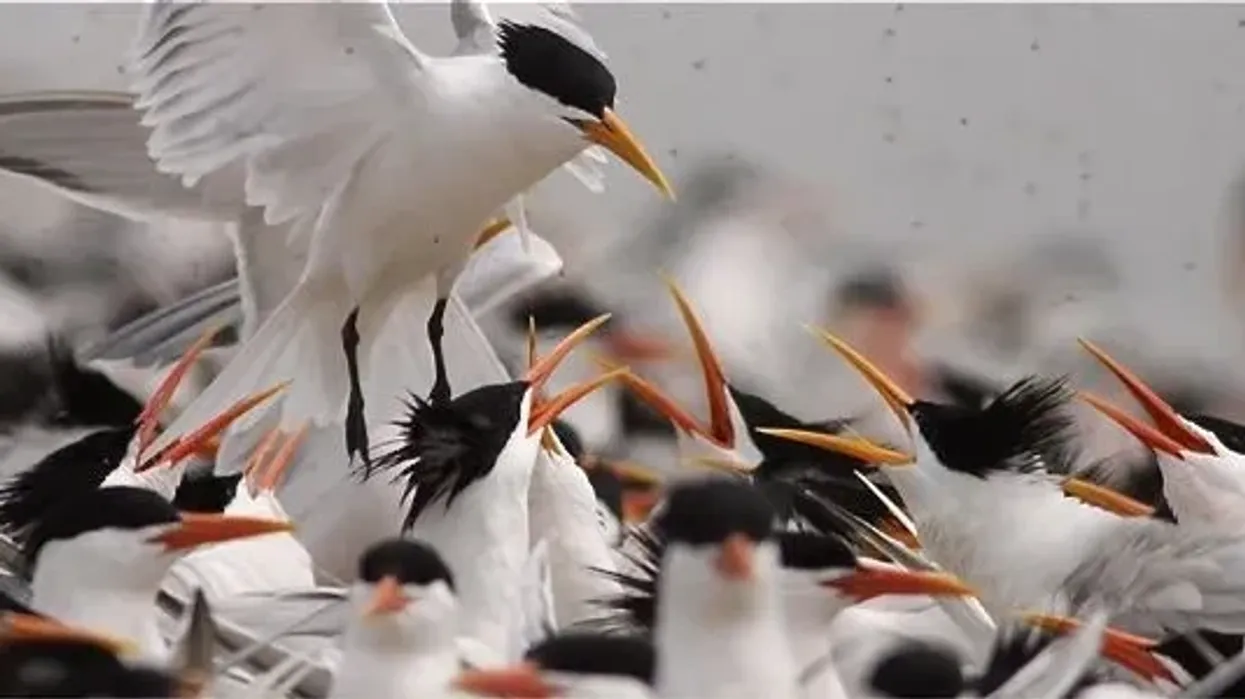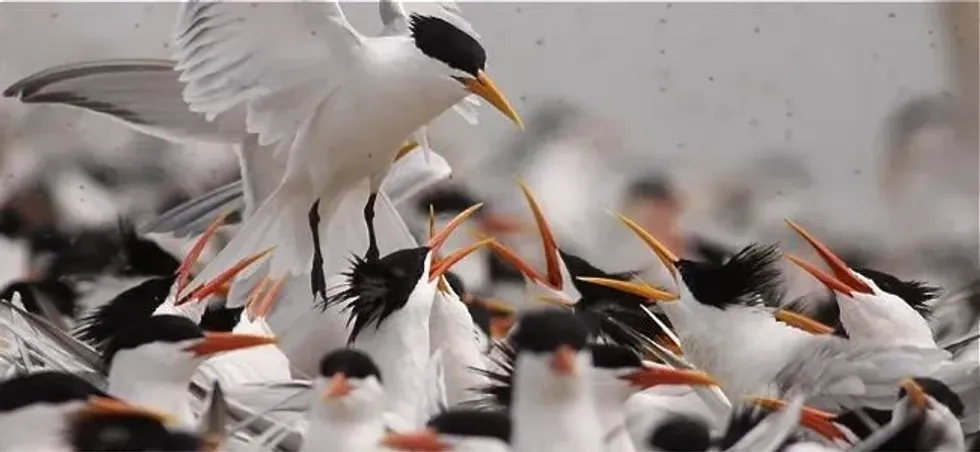It is pretty interesting to look at a bird plunge-diving from the air into the water's surface, gripping the fish in their bill and offering it to its mate. Surprisingly, they sometimes even travel up to 15 miles to catch one fish for its mate?
If you wish to view this, you ought to undoubtedly make a visit to Isla Rasa island within the Gulf of California, where you encounter Elegant terns breeding in enormous colonies, making plenty of noise shrieking 'karreck, karreck'. Are you desperate to know what it is?
The elegant tern (Thalasseus elegans) belongs to the Laridae and Charadriiformes orders of seabirds.
Over 90% of all elegant terns nest in a single colony. There only five known colonies exist, three on the southern California coasts and two in northeastern Mexico.
Their distribution and abundance are also dependent on its primary source of food—the Northern anchovy. When anchovies number is plentiful, terns have a high breeding success rate and vice versa.
Please scroll down to know more about them, to check out other interesting articles western bluebird facts or eastern kingbird facts.
Elegant Tern Interesting Facts
What type of animal is an elegant tern?
The elegant tern (Thalasseus elegans) is a sleek seabird species that lives along the Pacific North American coastline, staying out at various locations throughout the year.
What class of animal does an elegant tern belong to?
Elegant terns (Thalasseus elegans) are members of the Aves class from the family of Laridae. The Laridae is a seabird family in the order Charadriiformes that contains gulls, terns, and skimmers.
How many elegant terns are there in the world?
As per a study by Partners in Flight, there are 180,000 of these North American birds of order Charadriiformes nesting in its breeding range, with the majority of the population situated on Isla Rasa in the Gulf of California.
Where does an elegant tern live?
If you want to spot these birds in the wild as they breed on Pacific coasts, you need to visit islands in the Gulf of California; well, most of the population is known to exist on Isla Rasa, off the coast of Baja California, and near San Diego, California.
From mid-summer to late-fall, post-breeding, these birds migrate north to the central California coast.
During the winter range, nest along the western South American coast, from Peru to Chile.
What is an elegant tern's habitat?
The elegant tern (Thalasseus elegans) is a coastal species; you will find them in tropical waters, bays, estuaries, and sometimes even far out to sea. They are pretty unusual on freshwater lakes and inland.
However, coming to the breeding location, Elegant tern is limited to only five locations in Mexico and Southern California which are isolated, flat, sandy, or rocky islands with little vegetation.
Who do elegant terns live with?
These species usually nest in large colonies alongside other species, such as Heermann's Gulls in its distribution. However, they also prefer breeding near larger Caspian terns in California, which may help with predator protection.
How long does an elegant tern live?
These elegant terns live for 20 years or more in the wild.
How do they reproduce?
It's lovely to see how they perform themselves to exhibit their courtship display. Once coupled, Elegant terns start their courtship display both in the air and on the ground.
On land, females lower their heads in a groveling posture, seeking food just like a chick, while males present them with a small fish, lifting the crest, holding high, and drooping the wings, all the while calling and flick the bill upward.
Later, in the air, the male and female fly together and glide in parallel, quickly raising the wings in sync in a V shape, gliding and calling together for 10 seconds or more, then repeating this beautiful order multiple times. So they are undoubtedly monogamous in mating.
They build their nests on the bare ground scrape in the open.
Following mating, the female lays one or possibly two eggs. For four weeks, both parents incubate the egg and feed the chick.
The chick stays in the nest for about a week after hatching.
As soon as the chicks are active, the adults gather them into a crèche, but they can always recognize and feed their chicks in these groups. The parents continue to feed their chick long after it has fledged, and family groups stay together for at least six months after hatching.
What is their conservation status?
AS per the IUCN Red List, the elegant tern conservation status is Near Threatened, indicating less severe concerns or only potential vulnerability because 95% of the population is restricted over one island, Isla Rasa, in the Gulf of California.
Elegant Tern Fun Facts
What do elegant terns look like?

The elegant tern is a medium-sized tern with a long orange bill that droops slightly. Its head is a contrasting black cap with the longest shaggy crest of any tern and a white face.
It has pale grey upper wings and a white breast and belly with a pink flush. It has black legs, narrow, angled wings, and a deeply forked tail.
The breeding plumage and non-breeding are similar, but with a white forehead crest and a lack of pink flush. Juvenile or immature elegant tern has the same appearance as non-breeding adults, but juvenile elegant tern leg color is yellow.
How cute are they?
These birds have pale grey above, white with pink blush below, along with a shaggy black crest, forked tail, and an orange bill can be count as one among the cute member of seabirds. They are one of the most visually appealing species. Isn't it?
How do they communicate?
These birds are vocal and communicate through a variety of calls. The most common call is sharp and high, described as 'karreeek, karreeek'. It is similar to a royal tern's call but shorter and higher in pitch. When disturbed by other terns or predators, breeding birds make lower-pitched 'gak-gak' and 'kut-kut' calls similar to least tern or sandwich tern.
How big is an elegant Tern?
These birds measure 15.3-16.5 in (39-42 cm) in length. These are larger in size than common terns but smaller than royal terns.
How fast can an elegant tern fly?
These birds are known for their fast direct flights, quick turns, and ability to hover and plunge-diving while pursuing fish, yet to record their flight speed.
How much does an elegant tern weigh?
This bird weighs between 6.7-11.5 oz (190-325 g).
What are the male and female names of the species?
There are no sex-specific names for elegant terns.
What would you call a baby elegant tern?
There is no specific name for a baby elegant tern, but it is commonly referred to as a chick.
What do they eat?
Elegant terns diet often include small, schooling fish, especially the Northern anchovy and, on rare occasions, small crustaceans.
Are they poisonous?
There is no information that these elegant terns are poisonous to humans.
Would they make a good pet?
These species with white grey plumage and an orange bill may attract you to keep them as pets, but we will not able to provide them with their natural habitat of nesting on beaches and sandy islands as large colines. We would not recommend keeping this bird as a pet as they look better in the wild.
Did you know...
We can easily get confused this bird with the royal tern and the Forster's tern on a number of occasions. In elegant tern vs. royal tern, we have to remember that the royal tern is larger and has a thicker bill and whiter forehead in winters. When out of range, it is often confused with the smaller crested tern.
Are elegant terns endangered?
It is observed that most former breeding colonies of these birds in the Gulf of California, Mexico, have weakened. Once a high habitat species, it is now classified as Near Threatened by the IUCN.
The main reason for its extinction is restricted habitat, secondly due to urban development, which threatens the size and quality of nesting sites.
It is also recorded that rising coastal California water temperatures had altered the distribution and abundance of northern anchovies, affecting elegant tern's diet. Although terrestrial predators are absent from traditional nesting grounds, introduced mammals in its habitats such as house cats, rats, and stray dogs also impacted their colonies in the Gulf of Mexico.
What is unique about an elegant tern?
The most unique about elegant terns is that they breed only in Mexico's Gulf of California; Otherwise, we can spot these bird species along the California harbor in the spring and fall, where they feed just behind the beaches in the Pacific Ocean as well as in protected ocean regions like San Diego Bay, Monterey Bay, Morro Bay, and San Francisco Bay.
Here at Kidadl, we have carefully created lots of interesting family-friendly animal facts for everyone to discover! Learn more about some other birds from our toco toucan facts and hyacinth macaw facts pages.
You can even occupy yourself at home by coloring in one of our free printable elegant tern coloring pages.









